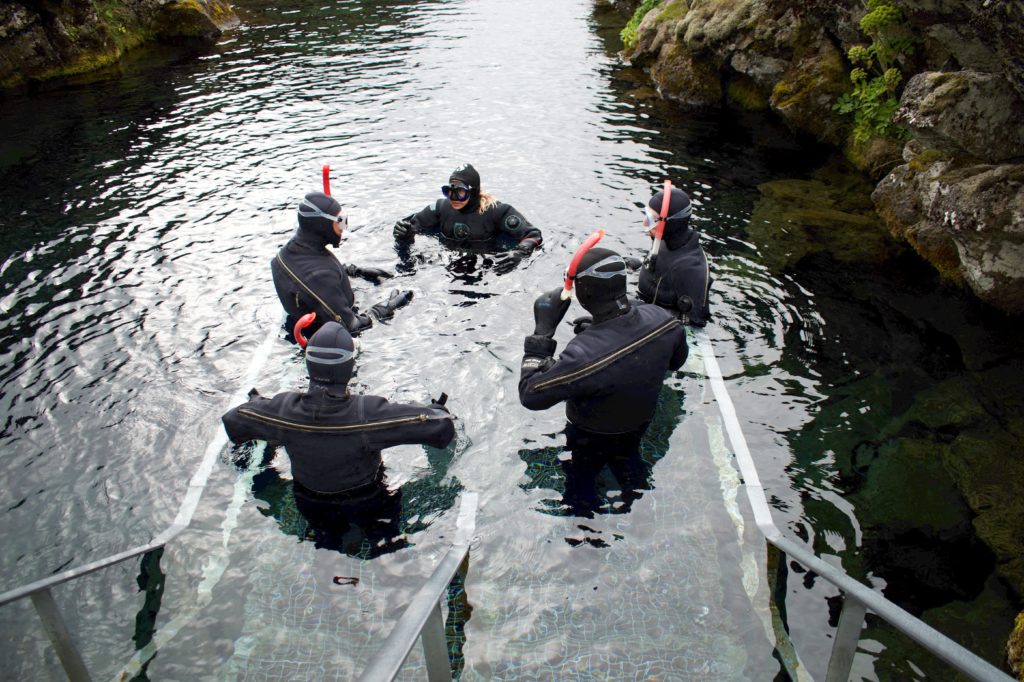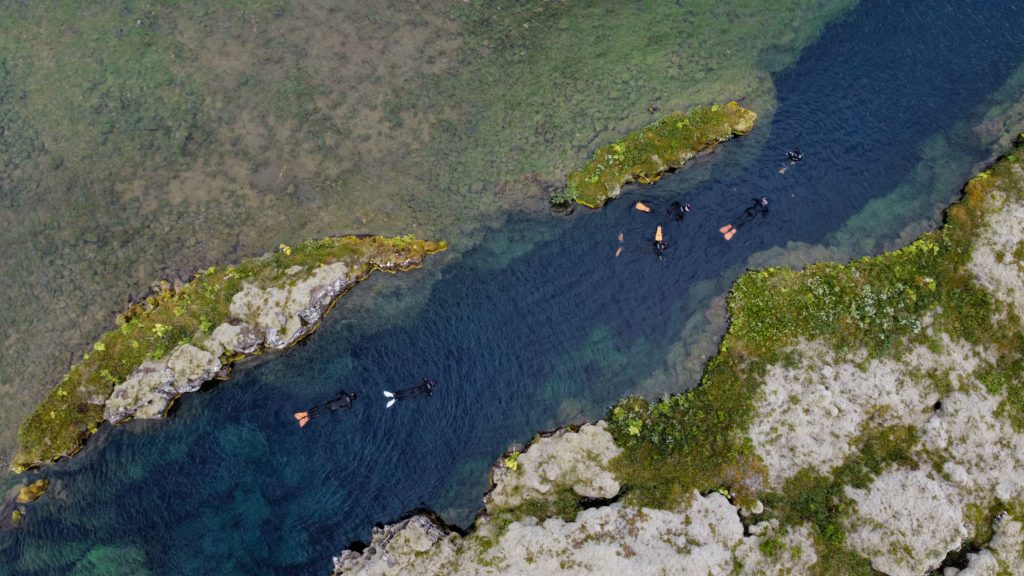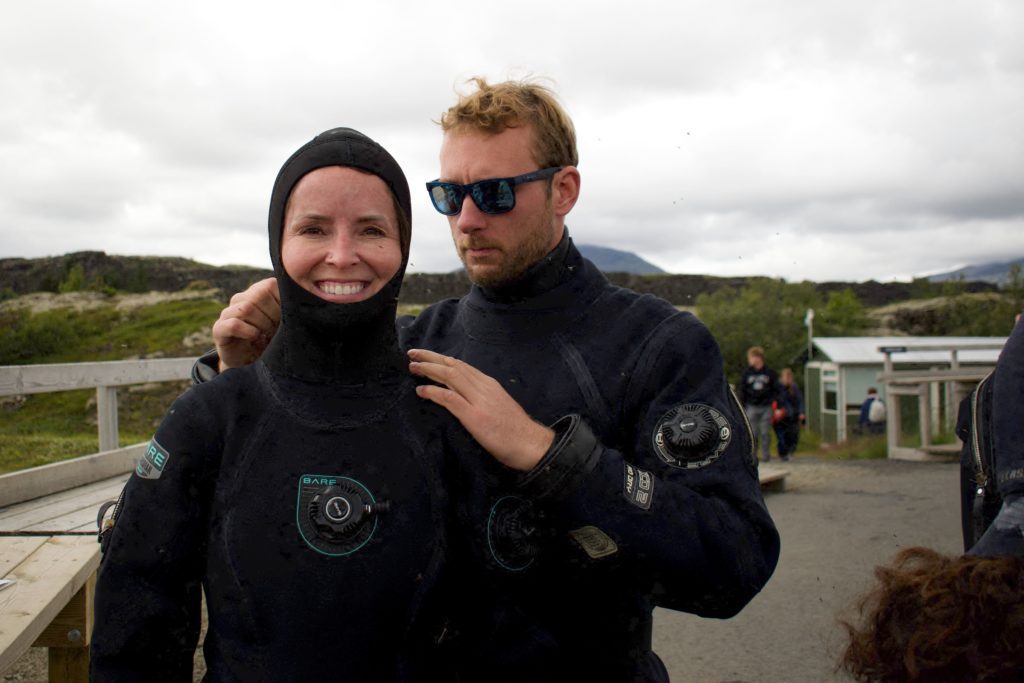MAL ROGERS heads to Iceland to see at first hand the gap between America and Eurasia
 A final pep talk (Getty Images)
A final pep talk (Getty Images)My left hand was in North America, my right hand was in Europe. This is not normally an easy trick to perform, but Silfra Canyon in Iceland technically speaking separates North America from Eurasia.
“Technically speaking” usually means “not really”, but here in southwest Iceland it certainly is true. Silfra is a fissure between two continental, or tectonic, plates located in Thingvellir National Park.
The massive forces of these plates occasionally cause earthquakes, and sometimes spectacular volcanic eruptions releasing molten rock and lava — so don’t forget your brolly.
Silfra is about 50km northeast of Reykjavik. On a clear day, from the Icelandic capital you can see the glacier-capped Snæfellsjökull volcano across wide Faxaflói. Viewed from here, the giant shimmering diamond of ice seems suspended between sea and sky. Novelist Jules Verne imagined that this was the entrance to the centre of the Earth, and mystics, Verne aficionadas and hippies still journey here to commune with the forces of the universe.
Despite having no confirmed adherence to any of these niche communities, I visited. In fact I was staying in the shadow of the volcano on Snaefellsnes Peninsula. From my room in the Budir Hotel I had a clear view of peak — if Snæfellsjökull blew, I’d have a grandstand view and Instagrams to beat the band, were I to survive.
But nothing untoward seemed to be happening as far as I could tell. The view from the Budir appeared to indicate that all was quiet.
A treeless expanse stretched towards the volcano. Bubbling black cauldrons contrasted with the jagged mountains, the glaciers glistening white. If you’re a fan of desolate and strange landscapes, you’ll scarcely do better.
The Budir, as you may have guessed by now, has no carefully manicured lawns, no shrubberies, no ornamental trees. As the phlegmatic Styrt, the manager pointed out, "Plants die quickly up here, unless they are lovingly cared for. In which case they die slowly." Styrt would be played by Gary Oldman in the movie about the journey.
After only two nights at the Budir I reluctantly had to get on the road again.
Because I was headed for Silfra, and those tectonic plates.
 The Silfra Fissure (Photo by JEREMIE RICHARD/AFP via Getty Images)
The Silfra Fissure (Photo by JEREMIE RICHARD/AFP via Getty Images)Just about everywhere in Iceland volcanoes growl deep beneath the earth’s crust. The movement of magma causes earthquakes throughout the country. Tectonically speaking, the plates can do likewise.
One earthquake in 1789 exposed a fissure that left Silfra Canyon the only place in the world where you can dive or snorkel directly in a crack between the plates separating America and Eurasia.
This is where Jules Verne should have headed — you can well believe that looking into this canyon you might be able to spot the earth’s core. In fact, I may well have.
This product of geological happenstance would be reason enough to visit the area just to stand and gawp, but there’s more. Water from Langjökull glacier gurgles and flows gently down the fissure and into Lake Thingvellir. The water, filtered through porous underground lava for up to100 years before reaching the spring that feeds into Silfra, is probably the purest you’ll find anywhere. It’s certainly the clearest. There’s visibility of 100 metres below the surface. Tours down the river are always organised, with no facility for lone journeys, as far as I could ascertain.
 WHAT A DIVE Getting togged out for the journey (Photo by JEREMIE RICHARD/AFP via Getty Images)
WHAT A DIVE Getting togged out for the journey (Photo by JEREMIE RICHARD/AFP via Getty Images)To get down the waters of Silfra to Lake Thingvellir myself and the rest of the party were togged out in dry suits so that we could float downstream, between America and Eurasia, as it were.
So, it was on with dry suits. These came with incredibly tight bands on wrists, ankles and necks. After all, the temperature of the water would be between 2 to 4 degrees C. This would be roughly the same temperature as that which greeted the passengers of the Titanic as they entered the water. Without dry suits, of course.
Then it was on with the snorkelling headgear, and the flippers.
We launched into the water, head first, carefully keeping our hands behind our backs as we drifted downstream. These were the only part of our body exposed to the water, so best to keep them out of the near freezing temperatures as much as possible.
Soon I became unaware of the rest of the group as the current gently moved me down the channel. It was peaceful, and not cold at all inside my dry suit — it was almost like floating along in a warmish balloon.
Both sides of the tectonic plates were clearly visible, everything with a turquoise, bluish-green hue. The crystal clear waters revealed a unique plant ecology that has evolved in the extreme environment. To be fair, it’s mostly moss, with a few wispy green things called ‘troll hairs’.
But the colours are stupefyingly vivid. Even Fabergé might consider them a bit gaudy. The geology here looks like it’s made it up as it goes along — elements deep in the earth are brought to the surface by the geothermal activity with a resulting kaleidoscope of striking colours.
Finally we floated into Lake Thingvellir, pretty much dry, definitely invigorated, and with a better grasp of geology than many of us had ever imagined would be possible.
A few years ago, I think around 2019 or 2020, Iceland re-affirmed its claim to the waters around Rockall. These, as you know, are already at the centre of a slow-burn diplomatic dispute between Britain and Ireland. It seems that Iceland has entered this bickering. But if you’ve got somewhere as magical as Silfra, why on earth would you want a rocky outpost like Rockall?

